| |
|
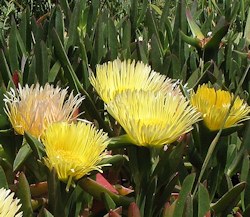 | |
| MaltaWildPlants.com by Stephen Mifsud |

|
| |
|
|
 |  |  |  |
| External Links: |
|
Oxalis pes-caprae (Bermuda Buttercup) |
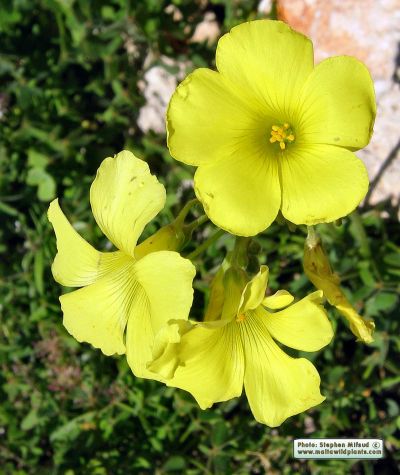
Oxalis pes-caprae (OXALIDACEAE.)
Images for this profile are taken from the Maltese Islands after year 2000. |
|
| Nomenclature |
Species name : | Oxalis pes-caprae L. | Authority : | Carl von Linne, Sweden, (1707 - 1778) | Synonyms :
(basionym or principal syn.) |
|
Plant Family : | Oxalidaceae R. Br.
(WoodSorrel Family) | English name(s) : | Bermuda Buttercup, Sour Sob, Cape Sorrel | Maltese name(s) : | Ħaxixa Ingliża, Qares | Status for Malta : | Invasive Alien. Species that was introduced in Malta any time after year 1492 (Columbus' discovery of the New World),
and spreads rapidly to form large invasive populations to the detriment of native flora or ecosystems. | Name Derivation : |
Oxalis: sour, acidic, or acrid-tasting, referring to the sour taste of the sap due to the high level of Oxalic acid that is present in most species, especially in the stems, leaves and roots. (Greek origin ); 2 = derived from "sour", due to oxalic acid in leaves and roots (Greek);.
pes-caprae: having the shape of a foot of a goat (pes = foot; capra = goat) alluding to the shape of the leaflets. (Latin origin ); 2 = looking like the foot of a goat; "pes" = foot, "capra" = goat (Latin).
| Remarks : | |
|
| Morphology and structure |
PLANT STRUCTURE: |
Character | Growth Form | Branching | Surface |
Description | | | |
General
Picture |  | 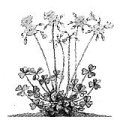 | 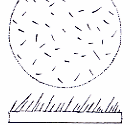 |
|
LEAVES: |
Character | Arrangement | Attachment | Venation |
Description | | | |
General
Picture |  | 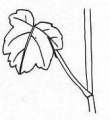 |  |
| |
Character | Leaf Shape | Leaf Margin | Remarks |
Description | | | Leaf Pigmentation Leaves are green with few to several dark purple blobs randomly scattered across the leaf blade. |
General
Picture |  |  |  |
|
FLOWERS: |
Character | Colour | Basic Flower Type | No. of Petals | No. of Sepals |
Description | Bright yellow | | 5 | 5 |
General
Picture | | 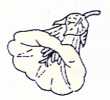 |  |  |
| |
Character | Inflorescence | Description | Ovary | Stamens |
Description | | Flower made up of 5 petals fused at the base forming the shape of a trumpet or funnel. It possesses 10 stamens (arranged in two rows of different levels) 5 stigmas further down the flower neck very close to the receptacle. | | |
General
Picture | 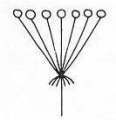 |  | 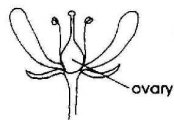 |  |
| |
Character | Scent | Average Flower Size | Pollen Colour | Other Notes |
Description | YES Very sweet delicate fragrance. | 30-32mm (unstretched). | Yellow | - |
|
SEEDS: |
Character | No. Per Fruit | Shape | Size | Colour |
Description | nil (Seed formation is extemely rare in Malta, plant spread vegetatively by underground bulbils). | n/a | n/a | n/a |
General
Picture |  |  |  |  |
|
FRUIT AND OTHER BOTANICAL DATA: |
Character | Fruit Type | Colour of Fruit | Subterranean Parts | Other Notes |
Description | | n/a | | - |
General
Picture |  |  |  |  |
|
|
| Plant description and characters | |
Life Cycle: | Perennial. |
Growth Form: | GEOPHYTE (bearing underground bulbs, rhizomes, stolons, etc.) |
Habitat: | Waysides, Wasteland, damp places, valleys, field tracks, stony walls, garigue and several other habitats. |
Frequency: | Very Common |
Localities in Malta: | Very Common throughout the Maltese Islands. Could be considered as the most abundant wild plant in Malta during January and February. |
Plant Height: | 10-30cm. |
| Dec-Apr |
Protection in Malta: | Not legally protected till the last update of this website (2/Mar/2022) |
Red List 1989: | Not listed in the Red Data Book of the Maltese Islands |
Poison: | |
A very common perennial plant of about 10-30cm height that flowers in Malta during early Winter till April. The plant is seen on our islands for about 6 months from when it set up leaves in Oct/Nov till May, but has perennial bulbous roots which remain alive all year round. Roots are buried underground (ocassionally in cavities of rubble walls) and produce many small peanut-sized, brown bulbs called bulbils each giving rise to a plant.
A stem lying just udergroung or at soil level is formed from the bulbil which in turn develops a cluster of unbranched stalks holding leaves or flowers. Leaf stalks bear a single compound trifoliate leaf (made of 3 leaflets) at its apex. Each of the 3 leaflets has the shape of an inverted heart. Few to many dark purple speckles are often observed on the leaves.
Flower stalks form an umbellate cymes of about 6 to 12 (-18) flowers. Each flower consists of 5 small, lance-shaped, green sepals and 5 bright yellow petals (20-25mm length) which collectively form a funnel or trumpet shaped corolla. The male reproductive organs consist of 2 whorls of 5 stamens each, the upper whorl having fertile stamens with long filaments and the other row below consists of non-fertile stamens. The female organs are located at the bottom of the flower and consist of five small pistils united at the base.
The fruit is a poricidal capsule, rather cylindrical in shape with slits at the walls from which the tiny seeds escape, such as by mechanical swaying indiced by wind. The plant rarely produce fruits, and never observed in our islands. One of the most common wild plants in Malta which is believed to have spread out by translocation of underground bulbils in a relatively short period of 200 years from the introduction of 1-2 dozen of plants in the beginning of the 19th century.
|
|
| Information, uses and other details |
Nativity and distribution
Notes about Oxalis (from freedictionary.com)
Oxalis is the largest genus in the wood sorrel family known as the Oxalidaceae. Of the approximately 900 known species in the Oxalidaceae, 800 belong to Oxalis. Many of the species are known as Wood Sorrel or Woodsorrel. The genus occurs throughout most of the world, except for the polar areas; species diversity is particularly rich in tropical Brazil and Mexico and in South Africa. [WWW-70]
These plants are annual or perennial. The leaves are divided into three to ten or more round, heart-shaped or lanceolate leaflets, arranged in a whorl with all the leaflets of roughly equal size. The majority of species have three leaflets; in these species, the leaves are superficially similar to those of some clovers, though clovers differ in having the leaflets not in a whorl, and of unequal size with two smaller side leaflets and one larger central leaflet. The flowers have five petals, usually fused at the base, and ten stamens; the petal colour varies from white to pink, red or yellow. The fruit is a small capsule containing several seeds. The roots are often tuberous, and several species also reproduce vegetatively by production of bulbils, which detach to produce new plants. [WWW-70]
Notes about Oxalis (from quattrofolium.com)
The main genus of the Wood Sorrel family is Oxalis, which has some 800 sorts. The genus owes its name to the embedded calciumoxalate-crystals (oxalic acid). The plants of this genus really grow everywhere on our planet. Especially rich in genera are the Andes, the tropical regions of Brazil, Mexico and South Africa. [WWW-160]
In this group are both annual plants and perennial shrubs. The oxalis plants are not of any economic significance. In former times, oxalis acetosella was used in the Black Forest to produce out of a weight of 75 kg leaves and amount of 500 g oxalic acid for technical purposes. [WWW-160]
The cloverleaf is also born as the heraldic emblem on the Irish coat of arms. It used to be eaten as salad or side dish due to its somewhat sour taste. People living in the Andes eat the root tubercules and the oxalis tuberosa's stems which are above ground. These large tubercules which are rich in starch are a called "oca" and still represent a very important basic food of the population there. We mistakenly call oxalis deppei "four-leaved clover" as it actually has four leaves like ours. This sort, originating from Mexico, was imported in 1822 and belongs to the sorts which are not hardy. Those bulbs that have been propagated by means of a complicated procedure are designed for being sold in October. 95% of these ornamental plants sold are put up to sale during the weeks before Christmas and the days before New Year. [WWW-160]
Notes about Oxalis (from wikipedia.com)
Oxalis is the largest genus in the wood sorrel family Oxalidaceae. Of the approximately 900 known species in the Oxalidaceae, 800 belong to Oxalis. Many of the species are known as Wood Sorrel or Woodsorrel. The genus occurs throughout most of the world, except for the polar areas; species diversity is particularly rich in tropical Brazil and Mexico and in South Africa. [WWW-60]
These plants are annual or perennial. The leaves are divided into three to ten or more round, heart-shaped or lanceolate leaflets, arranged in a whorl with all the leaflets of roughly equal size. The majority of species have three leaflets; in these species, the leaves are superficially similar to those of some clovers, though clovers differ in having the leaflets not in a whorl, and of unequal size with two smaller side leaflets and one larger central leaflet. Some species exhibit rapid changes in leaf angle in response to temporarily high light intensity. The flowers have five petals, usually fused at the base, and ten stamens; the petal colour varies from white to pink, red or yellow. The fruit is a small capsule containing several seeds. The roots are often tuberous, and several species also reproduce vegetatively by production of bulbils, which detach to produce new plants. [WWW-60]
Toxic Hazards
The leaves contain oxalic acid, which gives them their sharp sour flavour. Perfectly all right in small quantities, but the leaves should not be eaten in large amounts since oxalic acid can bind up the body's supply of calcium leading to nutritional deficiency. The quantity of oxalic acid will be reduced if the leaves are cooked. People with a tendency to rheumatism, arthritis, gout, kidney stones or hyperacidity should take special caution if including this plant in their diet since it can aggravate their condition. [238]
Reports of livestock animals and pets have been reported to die due to Oxalic acid / oxalate poisoning [WWW-12]. Read these documents regarding oxalic acid poisoning:
Doc 1: Oxalate Poisoning by Kimberly Page
Doc 2: Oxalate Poisoning by Mary C. Smith
Doc 3: Lethal Blood concentration of oxalate in humans (pdf file).
Other ecological Impacts:
O. pes-caprae is a garden weed in many regions, and can easily spread throughout a garden into nearby lawn and turfgrass areas. It can form dense mats on the ground, out-competing native plant species for light and space, and also works to inhibit the germination of native species. Additionally, it may cause oxalate poisoning in livestock if eaten in large quantities. [WWW-11]
Growing conditions:
Easily grown in a sandy soil in a warm dry position [1], but it also grows well in clayey soil here in Malta. Preferred habitat is however abandoned fields with loamy, fertile and suitably deep soil.[SM] Plant tolerates temperatures down to about -5°C [90].
Reproduction:
Plants spread rapidly when in a suitable environment and can quite easily become a weed in virtually frost-free environments [200, 260]. Plants seldom produce seed in Europe but they spread by means of asexually produced bulbils [200]. Each mother bulb is capable of producing more than 20 bulbils (smaller bulbs) per year, which are then spread by the transport of contaminated soils or garden refuse. Heavy earth-moving equipment and cultivation techniques may also disperse bulbils So it seems that the flowering is a waste of energy and useless since seeds are not produced. But despite of that, this plant produce so many flowers that it can form yellow carpets in certain conditions and habitats. [WWW-11]
The underground movement and development of roots and bulbs:
The underground movement of Oxalis pes-caprae L. is a combination of shoot elongation and root contraction. Its function is the dispersal of renewal bulbs located in the axils of the scale leaves. At the beginning of root contraction the bulb leaves become detached from the bulb bottom and remain at their initial position. Bulb bottom and contractile root form a turnip-shaped unit. Its proximal end becomes displaced by shortening of the root. While contracting, the root develops a pulling force, which is quantified by using the lifting method. Connection between the over-ground shoot and the contractile root is maintained by a few short basal internodes of the new shoot, which elongate to form a thin underground "thread". Elongation of the thread and shortening of the root reach 20-30 cm and obviously occur synchronously, whereby the thread remains taut during movement. Along the thread several lateral buds emerge. These develop into renewal bulbs usually reaching the size of the mother bulb. [276]
Origin:
The plant is native to Cape, South-West of South Africa. It was introduced as an ornamental plant to the Mediterranean Basin in the beginning of the 19th century and to Australia circa in 1839 [WWW-12]. The plant liked the Maltese environment and dispersed rapidly throughout within th first 50-100 years. (Read further down for more info about introduction of the plant in Malta)
Personal Observations:
Light sensitivity:
The plant is particularly sensitive to light. The flowers need full sunlight to open, otherwise their petals roll on each other and remain closed. Slightly cloudy weather or shade can cause the flower to close. The leaves are also able fold and 'close', but they do this only during night. [SM]
Abundance in Malta
This is undoubtfully the most common plant in Malta during the months of January and February (sometimes even March), next to the other common plant, the Crown Daisy (Glebionis coronaria) which flowers a bit later. It can form carpets of yellow flowers in abandoned fields, vineyards, waysides, countrylanes or any soily wasteland. The preferred habitat of O. pes-caprae in Malta is certainly abandoned fields, along waysides, low rubble walls and disturbed areas in the countryside. [SM]
Origin of the plant and its Maltese name 'Ingliza'
The origin of the Maltese name "Haxixa Ingliza" which literally means English grass (=plant), is probably derived due to the fact that the plant was introduced in Malta circa 1806 [279] not long after when the English colony ruled Malta (1800-1974). The Bermuda Buttercup was introduced by an english taveller lady who donated some plants to Carlo Giacinto. Giacinto was a Carmelite monk from Genoa and also the curator of the botanical gardens at Floriana [278]. This plant escaped and within few decades it spread through whole Malta, but amazingly, it also had escaped the island and became naturalised throughout the whole Mediterranean coast [279]. and subsequently along the Atlantic coast as far North as South Devon. [278]
Invasiveness of the plant in Malta
The plant has evolved so much that it contributes heavily for the reduction and perhaps extinction of certain local species. Strangely enough, this contrasts well with the fact that a parasite - endemic variant of a small broom-rape (Orobanche muteli f.melitensis) - switched from its usual previous host (a number of legume species), to the roots of the Bermuda buttercup and now grows exclusively on its roots. [278]
Double flower variant of O. pes-caprae
There is also a variation of the plant which has more beautiful rich yellow double-flowers. Additionally, the upper part of the flowering stalks has a copper brown colour. This variation is found in much less quantity in Malta then the normal variant. There is a good source of these variants at the countryside near Ghajn Tuffieha bay / Qarraba point. They are quite plenty here, esp in February, and in some areas their population is more abundant than the common variant. The botanical (scientific) name of this variant is Oxalis pes-caprae var. pleniflora and in Maltese it is called "Haxixa Ingliza Sewda" [SM]
Misc. notes
This plant is particularly resistant to most modern herbicides [279]
The petals have a type of fluorescent green dye which fluoresces better in the longer wavelength of uv light that is UV-A . [SM]
|
|
| Links & Further literature
(1 papers) |

Google Web |

Google Images |

Google Scholar |

Research Gate |

Wikipedia |

JSTOR |

GBIF |

Med Checklist |

Cat. of Life |

EoL |

IPNI |

World Flora Online |

Plants of the World Online |

Vienna Virt. Herb. |

RBGE Herbarium |

KEW Herbarium |

MNHN |

Arkive |

IUCN |

CABI |
 |
Updates in the Flora of the Maltese Islands (Central Mediterranean) |
Stephen Mifsud (2007) |
Kindly Email if there are papers and publications about local
studies or information about this species to be included in the list above.
|
| Photo Gallery (36 Images) | 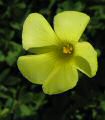 |
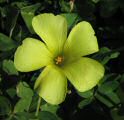 |
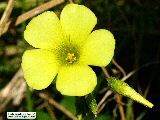 |
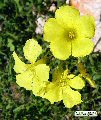 |
IMAGE: OXLPC-01 Photo of the bright yellow, trumpet-shaped flower. |
IMAGE: OXLPC-02 Close up photo of flower consisting of 5 petals that are partially fused at their base, and a cluster of 10 stamens (5 upper + 5 lower) in the centre. |
IMAGE: OXLPC-03 Photo of flower. It has a pleasant sweet scent, particularly noted when there are plenty of flowers. |
IMAGE: OXLPC-04 Close up image of a small cluster of flowers. |
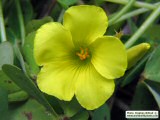 |
 |
 |
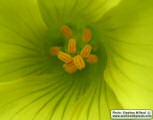 |
IMAGE: OXLPC-05 Close up photo of the bright yellow flower made up of 5 partially fused petals that possess 4-6 longitudinal greenish veins. At the centre of the flower reside the 10 stamens. |
IMAGE: OXLPC-06 Photo of flower in situ. |
IMAGE: OXLPC-07 Scanned image of flower against a dark background. |
IMAGE: OXLPC-08 Macro photo of central part of flower showing in detail the arrangement of the 10 stamens in two rows of 5 stamens each (one upper row and one lower). |
 |
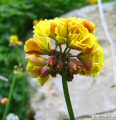 |
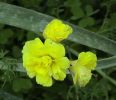 |
 |
IMAGE: OXLPC-09 Photo of the flower of the rare plant variant - Oxalis pes-caprae var. pleniflora - which is a 'double-form' of the normal species. Not as common as the normal form. |
IMAGE: OXLPC-10 Photo of Oxalis pes-caprae var. pleniflora. Apart from the flower having numerous and pleated petals, it also differs from the normal flower by having copper brown buds, sepals and lower petals. Some petals are also tinged with this reddish brown colour. |
IMAGE: OXLPC-11 Photo of Oxalis pes-caprae var. pleniflora . Found in Malta at Ghajn Tuffieha Bay and Qarraba region amongst other places throughout the whole islands with rich soil. |
IMAGE: OXLPC-12 Close up photo of Oxalis pes-caprae var. pleniflora. |
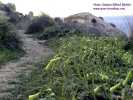 |
 |
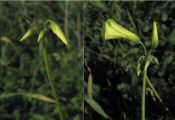 |
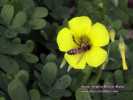 |
IMAGE: OXLPC-13 Photo of the typical habitat of the plant, hence along waysides or walls. |
IMAGE: OXLPC-14 Photo of flowers closed up due to insufficient daylight. Even when it is hazy or partially cloudy with several hours of sunlight, The flowers remain closed. They usually open on full sunshine. |
IMAGE: OXLPC-15 Photo of buds and the inflorescence. A small cluster of stalked flowers growing from the same apical pont of the flowering stalk. |
IMAGE: OXLPC-16 Photo of a flower visited by a bee. Bees are very attracted by the bright yellow flowers and the sweet scent. |
 |
 |
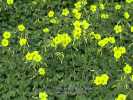 |
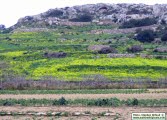 |
IMAGE: OXLPC-17 Scanned image of the backside of flower to show its small sepals. Note their curious yellow pointed tip. |
IMAGE: OXLPC-18 Scanned image of a dissected flower (with petals removes) to show its anatomy. It basicaly consists of 10 stamens and 5 stigma. |
IMAGE: OXLPC-19 Photo of a yellow carpet formed by the bright yellow flowers of O. pes-caprae. |
IMAGE: OXLPC-20 Typical photo of the Maltese countryside in late Winter (Feb-Mar) covered with extensive yellow patches of Oxalis pes-caprae. The weed extends also on several habitatsand stony walls. It can become a problem for farmers if it invades their fields. |
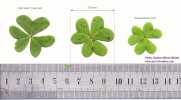 |
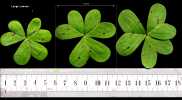 |
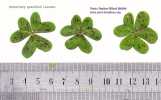 |
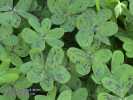 |
IMAGE: OXLPC-21 Scanned image of leaves: Normal leaves contain few dark violet (like the colour of potassium permanganate) speckles randomly scattered around the leaf. |
IMAGE: OXLPC-22 Scanned image of leaves: Very large leaves, about 2 times the normal size. These leaves were taken from plants situated all day in shade. |
IMAGE: OXLPC-23 Scanned image of leaves: Intensively speckled leaves, with about 3 or 4 times as much specks than in a normal leaves. |
IMAGE: OXLPC-24 Scanned image of leaves which are intensively speckled. |
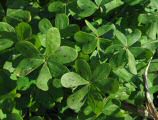 |
 |
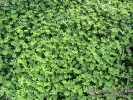 |
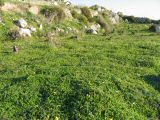 |
IMAGE: OXLPC-25 Close up photo of speckled large leaves in situ. |
IMAGE: OXLPC-26 Enlarged picture of the leaf speckles. |
IMAGE: OXLPC-27 Carpet of leaves covering all ground leaving little space and light for other plants. |
IMAGE: OXLPC-28 Carpeting could be very extensive. This invasive growth makes it harder for other native wild plants to survive. |
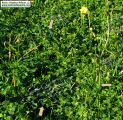 |
 |
 |
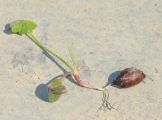 |
IMAGE: OXLPC-29 Photo illustrating the effect of Bermuda buttercup overgrowing other plants (marked with arrows). The taller plants are only partially effected, but the low growing plants will be covered by the higher vegetation of the Bermuda buttercup and so receive much less direct sunlight with the likely risk of dying due to insufficient photosynthesis or suffer unsuccesful flowering. |
IMAGE: OXLPC-30 |
IMAGE: OXLPC-31 Various images of the pollen under light microscope at various magnifications (x 100 - x 400). |
IMAGE: OXLPC-32 Brown, peanut-sized bulbil from which the plant germinates and propagates. Propagation by seeds is extremely rare in Malta. A main root (or true stem) emerges from the bulbil, and when it reaches ground level, it forms several leaf stalks and one, taller flowering stalk. |
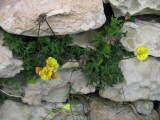 |
 |
 |
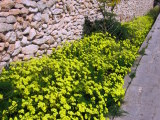 |
IMAGE: OXLPC-33 Photo of Oxalis pes-caprae var. pleniflora growing from stone walls. Apart having different flowers from the common Bermuda buttercup, this variety has darker leaves (often unspeckled) and a darker peduncle. |
IMAGE: OXLPC-34 Close up photo of a beautiful Oxalis pes-caprae var. pleniflora flower. |
IMAGE: OXLPC-35 Photo of a pale and rather small flower of this plant. Might be a new variety but more probably a defect or a diseased plant. |
IMAGE: OXLPC-36 Photo of several plants lining a stone wall at the Hagar Qim Temples of Qrendi. |
|
| | |

